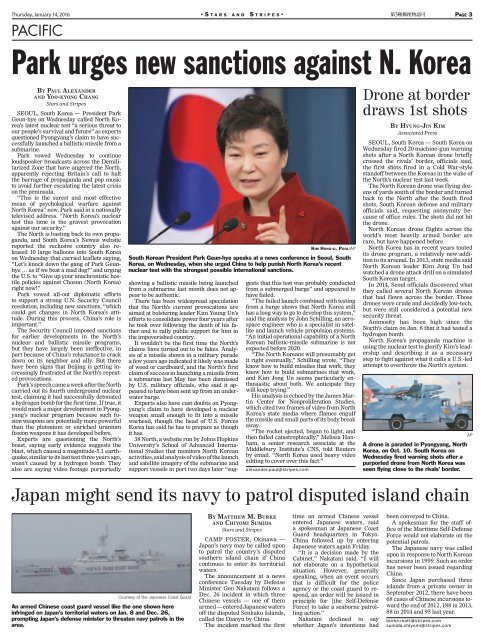QUICK RELEASE
GSS_GSS_140116
GSS_GSS_140116
You also want an ePaper? Increase the reach of your titles
YUMPU automatically turns print PDFs into web optimized ePapers that Google loves.
Thursday, January 14, 2016<br />
PACIFIC<br />
BY PAUL ALEXANDER<br />
AND YOO-KYONG CHANG<br />
Stars and Stripes<br />
SEOUL, South Korea — President Park<br />
Geun-hye on Wednesday called North Korea’s<br />
latest nuclear test “a serious threat to<br />
our people’s survival and future” as experts<br />
questioned Pyongyang’s claim to have successfully<br />
launched a ballistic missile from a<br />
submarine.<br />
Park vowed Wednesday to continue<br />
loudspeaker broadcasts across the Demilitarized<br />
Zone that have angered the North,<br />
apparently rejecting Britain’s call to halt<br />
the barrage of propaganda and pop music<br />
to avoid further escalating the latest crisis<br />
on the peninsula.<br />
“This is the surest and most effective<br />
mean of psychological warfare against<br />
North Korea” now, Park said in a nationally<br />
televised address. “North Korea’s nuclear<br />
test this time is the gravest provocation<br />
against our security .”<br />
The North is basting back its own propaganda,<br />
and South Korea’s Newsis website<br />
reported the reclusive country also released<br />
10 large balloons into South Korea<br />
on Wednesday that carried leaflets saying,<br />
“Let’s knock down the gang of Park Geunhye<br />
… as if we beat a mad dog!” and urging<br />
the U.S. to “Give up your anachronistic hostile<br />
policies against Chosun (North Korea)<br />
right now!”<br />
Park vowed all-out diplomatic efforts<br />
to support a strong U.N. Security Council<br />
resolution, including new sanctions, “which<br />
could get changes in North Korea’s attitude.<br />
During this process, China’s role is<br />
important.”<br />
The Security Council imposed sanctions<br />
for earlier developments in the North’s<br />
nuclear and ballistic missile programs,<br />
but they have largely been ineffective, in<br />
part because of China’s reluctance to crack<br />
down on its neighbor and ally. But there<br />
have been signs that Beijing is getting increasingly<br />
frustrated at the North’s repeated<br />
provocations.<br />
Park’s speech came a week after the North<br />
carried out its fourth underground nuclear<br />
test, claiming it had successfully detonated<br />
a hydrogen bomb for the first time. If true, it<br />
would mark a major development in Pyongyang’s<br />
nuclear program because such fusion<br />
weapons are potentially more powerful<br />
than the plutonium or enriched uranium<br />
fission weapons it has developed before.<br />
Experts are questioning the North’s<br />
boast, saying early evidence suggests the<br />
blast, which caused a magnitude-5.1 earthquake,<br />
similar to its last test three years ago,<br />
wasn’t caused by a hydrogen bomb. They<br />
also are saying video footage purportedly<br />
•STARS AND STRIPES• F3HIJKLM PAGE 3<br />
Park urges new sanctions against N. Korea<br />
showing a ballistic missile being launched<br />
from a submarine last month does not appear<br />
to be authentic.<br />
There has been widespread speculation<br />
that the North’s current provocations are<br />
aimed at bolstering leader Kim Young Un’s<br />
efforts to consolidate power four years after<br />
he took over following the death of his father<br />
and to rally public support for him in<br />
the impoverished country.<br />
It wouldn’t be the first time the North’s<br />
claims have turned out to be fakes. Analysis<br />
of a missile shown in a military parade<br />
a few years ago indicated it likely was made<br />
of wood or cardboard, and the North’s first<br />
claim of success in launching a missile from<br />
a submarine last May has been dismissed<br />
by U.S. military officials, who said it appeared<br />
to have been sent up from an underwater<br />
barge.<br />
Experts also have cast doubts on Pyongyang’s<br />
claim to have developed a nuclear<br />
weapon small enough to fit into a missile<br />
warhead, though the head of U.S. Forces<br />
Korea has said he has to prepare as though<br />
it has.<br />
38 North, a website run by Johns Hopkins<br />
University’s School of Advanced International<br />
Studies that monitors North Korean<br />
activities, said analysis of video of the launch<br />
and satellite imagery of the submarine and<br />
support vessels in port two days later “suggests<br />
that this test was probably conducted<br />
from a submerged barge” and appeared to<br />
have failed.<br />
“The failed launch combined with testing<br />
from a barge shows that North Korea still<br />
has a long way to go to develop this system,”<br />
said the analysis by John Schilling, an aerospace<br />
engineer who is a specialist in satellite<br />
and launch vehicle propulsion systems.<br />
“An initial operational capability of a North<br />
Korean ballistic-missile submarine is not<br />
expected before 2020.<br />
“The North Koreans will presumably get<br />
it right eventually,” Schilling wrote. “They<br />
know how to build missiles that work, they<br />
know how to build submarines that work,<br />
and Kim Jong Un seems particularly enthusiastic<br />
about both. We anticipate they<br />
will keep trying.”<br />
His analysis is echoed by the James Martin<br />
Center for Nonproliferation Studies ,<br />
which cited two frames of video from North<br />
Korea’s state media where flames engulf<br />
the missile and small parts of its body break<br />
away.<br />
“The rocket ejected, began to light, and<br />
then failed catastrophically,” Melissa Hanham,<br />
a senior research associate at the<br />
Middlebury Institute’s CNS, told Reuters<br />
by email. “North Korea used heavy video<br />
editing to cover over this fact.”<br />
alexander.paul@stripes.com<br />
KIM HONG-JI, POOL/AP<br />
South Korean President Park Geun-hye speaks at a news conference in Seoul, South<br />
Korea, on Wednesday, when she urged China to help punish North Korea’s recent<br />
nuclear test with the strongest possible international sanctions.<br />
Drone at border<br />
draws 1st shots<br />
BY HYUNG-JIN KIM<br />
Associated Press<br />
SEOUL, South Korea — South Korea on<br />
Wednesday fired 20 machine-gun warning<br />
shots after a North Korean drone briefly<br />
crossed the rivals’ border, officials said,<br />
the first shots fired in a Cold War-style<br />
standoff between the Koreas in the wake of<br />
the North’s nuclear test last week.<br />
The North Korean drone was flying dozens<br />
of yards south of the border and turned<br />
back to the North after the South fired<br />
shots, South Korean defense and military<br />
officials said, requesting anonymity because<br />
of office rules. The shots did not hit<br />
the drone.<br />
North Korean drone flights across the<br />
world’s most heavily armed border are<br />
rare, but have happened before.<br />
North Korea has in recent years touted<br />
its drone program, a relatively new addition<br />
to its arsenal. In 2013, state media said<br />
North Korean leader Kim Jong Un had<br />
watched a drone attack drill on a simulated<br />
South Korean target.<br />
In 2014, Seoul officials discovered what<br />
they called several North Korean drones<br />
that had flown across the border. Those<br />
drones were crude and decidedly low-tech,<br />
but were still considered a potential new<br />
security threat.<br />
Animosity has been high since the<br />
North’s claim on Jan. 6 that it had tested a<br />
hydrogen bomb.<br />
North Korea’s propaganda machine is<br />
using the nuclear test to glorify Kim’s leadership<br />
and describing it as a necessary<br />
step to fight against what it calls a U.S.-led<br />
attempt to overthrow the North’s system.<br />
A drone is paraded in Pyongyang, North<br />
Korea, on Oct. 10. South Korea on<br />
Wednesday fired warning shots after a<br />
purported drone from North Korea was<br />
seen flying close to the rivals’ border .<br />
Japan might send its navy to patrol disputed island chain<br />
AP<br />
Courtesy of the Japanese Coast Guard<br />
An armed Chinese coast guard vessel like the one shown here<br />
infringed on Japan’s territorial waters on Jan. 8 and Dec. 26 ,<br />
prompting Japan’s defense minister to threaten navy patrols in the<br />
area.<br />
BY MATTHEW M. BURKE<br />
AND CHIYOMI SUMIDA<br />
Stars and Stripes<br />
time an armed Chinese vessel<br />
entered Japanese waters, said<br />
a spokesman at Japanese Coast<br />
Guard headquarters in Tokyo.<br />
CAMP FOSTER, Okinawa — China followed up by entering<br />
Japan’s navy may be called upon<br />
to patrol the country’s disputed<br />
Japanese waters again Friday.<br />
“It is a decision made by the<br />
southern island chain if China Cabinet,” Nakatani said. “I will<br />
continues to enter its territorial not elaborate on a hypothetical<br />
waters.<br />
situation. However, generally<br />
The announcement at a news speaking, when an event occurs<br />
conference Tuesday by Defense<br />
Minister Gen Nakatani follows a<br />
Dec. 26 incident in which three<br />
that is difficult for the police<br />
agency or the coast guard to respond,<br />
an order will be issued in<br />
Chinese vessels — one of them principle for [the Self-Defense<br />
armed — entered Japanese waters<br />
off the disputed Senkaku Islands,<br />
Force] to take a seaborne patrolling<br />
action.”<br />
called the Diaoyu by China. Nakatani declined to say<br />
The incident marked the first whether Japan’s intentions had<br />
been conveyed to China.<br />
A spokesman for the staff office<br />
of the Maritime Self-Defense<br />
Force would not elaborate on the<br />
potential patrols.<br />
The Japanese navy was called<br />
upon in response to North Korean<br />
incursions in 1999. Such an order<br />
has never been issued regarding<br />
China.<br />
Since Japan purchased three<br />
islands from a private owner in<br />
September 2012, there have been<br />
68 cases of Chinese incursions toward<br />
the end of 2012, 188 in 2013,<br />
88 in 2014 and 95 last year.<br />
burke.matt@stripes.com<br />
sumida.chiyomi@stripes.com



